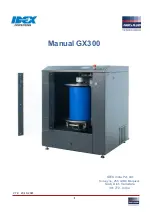
Effect
145
DME32—Owner’s Manual
Gate Reverb & Reverse Gate
The Gate Reverb component offers an early-reflection reverb with gate, while the
Reverse Gate component offers early-reflections with a reverse gate.
Both components feature one input and stereo outputs. Since the only difference
between these components is their reverb algorithm, only the Gate Reverb control win-
dow is shown here.
Each control window consists of early reflection controls, input level meter, stereo out-
put level meters, and reflection pattern type selector.
The IN meter displays the input signal level, while the OUT meters display the stereo
output signal levels.
Parameter
Range
Description
ROOMSIZE
0.1–20.0
Reflection spacing
LIVENESS
0–10
Early reflections decay characteristics
(0 = dead, 10 = live)
INI.DLY
0.0–500.0 ms
Initial delay before reverb begins
DIFF.
0–10
Reverb diffusion (left–right reverb spread)
DENSITY
0–100%
Reverb density
ER NUM.
1–19
Number of early reflections
HI.RATIO
0.1–1.0
High-frequency feedback ratio
FB. GAIN
–99 to +99%
Feedback gain
HPF
THRU, 21.2 Hz–8.00 kHz
High-pass filter cutoff frequency (THRU = filter off)
LPF
50.0 Hz–16.0 kHz, THRU
Low-pass filter cutoff frequency (THRU = filter off)
TYPE
Type-A, Type-B
Type of early reflection simulation
















































